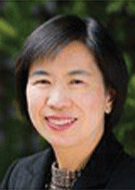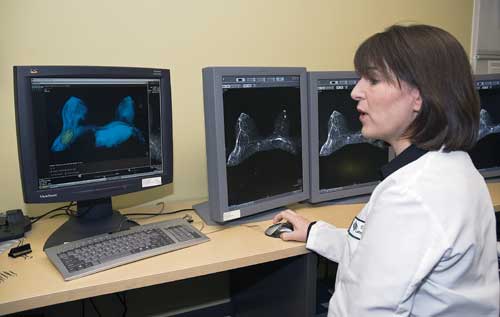MRI for Dense Breasts: Weighing the Benefits
Supplemental screening finds more cancers, but access and coverage remain challenges


The use of supplemental breast screening with MRI for women with dense breasts is controversial due to a lack of definitive research and capacity issues that limit the ability of a department to efficiently provide imaging services.
“For decades now, people have been struggling to determine the right answer for supplemental screening,” said Bonnie N. Joe, MD, PhD, the Edward A. Sickles Distinguished Professor of Radiology at the University of California, San Francisco (UCSF). “We don't have definitive guidelines on whether one type of supplemental screening is better than another.”
While considered the standard of care in breast cancer screening, mammography is not as effective in patients with dense breasts, which are an independent risk factor for cancer and can mask a tumor. In the U.S., the Food and Drug Administration requires patients to be notified of their breast density to ensure women have the information they need to make informed decisions about their breast health.
“Breast density is well-known to affect the sensitivity of cancer detection with mammography,” said Brandon K.K. Fields, MD, a radiology resident at UCSF. “However, insurance often doesn’t cover supplemental breast screening, and it’s unclear if it’s cost-effective for women with average to high breast density in the absence of other risk factors.”
Breast imaging practices around the country use screening breast MRI, contrast-enhanced mammography, whole breast US, or breast-specific gamma imaging to supplement screening mammography in women who have dense breasts without other predisposing factors to cancer.
“There are pros and cons for each supplemental screening method in terms of patient tolerance, benign biopsies, and local availability and expertise for a particular screening method,” Dr. Joe said. “There’s no one-size-fits-all answer.”
“There are pros and cons for each supplemental screening method in terms of patient tolerance, benign biopsies, and local availability and expertise for a particular screening method,” Dr. Joe said. “There’s no one-size-fits-all answer.”
– BONNIE N. JOE, MD, PHD
Data Supports Supplemental MRI Screening
A recent article in the Journal of Breast Imaging offered a meta-analysis of data on the role of supplemental breast MRI in screening women with dense breasts. Drs. Fields and Joe highlighted the research findings in a recent issue of Radiology: Imaging Cancer. Dr. Joe is deputy editor for the journal. Dr. Fields is an editor in training.
In the article, Michael Faheem, MBBS, MS, MRCS, PhD, and colleagues reviewed nearly 700 manuscripts published between 1995 and 2022. They included 24 studies on women between the ages of 19 and 87 years with heterogeneous or extremely dense (BI-RADS C/D) breasts in their final analysis.
“Based on the data, the authors concluded that MRI-based supplemental screening for patients with dense breast tissue detected more malignancies than mammography alone, the majority of which were invasive cancers,” Dr. Fields said.
In the first round of supplemental breast MRI performed after screening mammography, an estimated three times more malignancies were detected than with mammography alone. The cancer detection rate was 16.6 per 1000 examinations. In the second or subsequent supplemental MRI screen, the cancer detection rate was 6.8 per 1000 examinations. Of the mammographically occult cancers detected by MRI, 76% were invasive cancers.
“Most of us would consider these detection rates to be compelling,” Dr. Joe said. “I don’t think anyone questions the need for or potential benefits of supplemental screening MRI. The challenge for MRI is getting access to the exam and making sure we’re helping not harming.”
The Problem with Insurance
According to Dr. Joe, insurance coverage for supplemental MRI screening varies from state to state and among various insurance plans. “Data always helps, but at the end of the day, it’s hard to ensure adequate insurance coverage,” she said. “Even if coverage were not an issue, we don’t have the capacity right now to really meet the need.”
The Centers for Disease Control and Prevention report that approximately 40% of women in the U.S. are classified as having dense breasts, and many women desire supplemental screening. “At my institution, we have issues with getting standard of care needs, such as a diagnostic mammogram, covered without out-of-pocket costs,” Dr. Joe said. “We have high-risk patients who, per existing guidelines, should be getting annual MRIs, yet have trouble getting coverage.”
Dr. Joe said improvements in MRI technology could make the exam shorter and more tolerable. An abbreviated exam could also improve accessibility. “As we generate additional data, we hope that it will become compelling enough to justify insurance coverage,” she said.
In the meantime, Dr. Joe noted, this analysis will provide radiologists with evidence to use when talking with clinicians and referring providers.
“When patients talk to me about their breast density, it’s a good way to start the conversation about risk in general and what can be done in terms of prevention,” Dr. Joe said. “And not just breast cancer, but all cancers.”
She advises patients and providers to adhere to the standard of care and professional guidelines rather than pursuing whole-body MRI screening, which lacks data.
“Women who are informed and empowered will speak for themselves,” she said.
For More Information
Access the Radiology: Imaging Cancer highlight, “MRI-Based Supplemental Screening Improves Cancer Detection in Patients with Mammographically Dense Breast Tissue,” at RSNA.org/Imaging-Cancer.
Access the Journal of Breast Imaging article at Academic.oup.com/JBI.
Read previous RSNA News stories about breast imaging:
- Racial Disparities Seen in Same-Day Breast Diagnostic and Biopsy Services
- Late-Stage Breast Cancer Diagnosis on the Rise in U.S.
- Shorter MRI Exam Effectively Detects Cancer in Dense Breasts